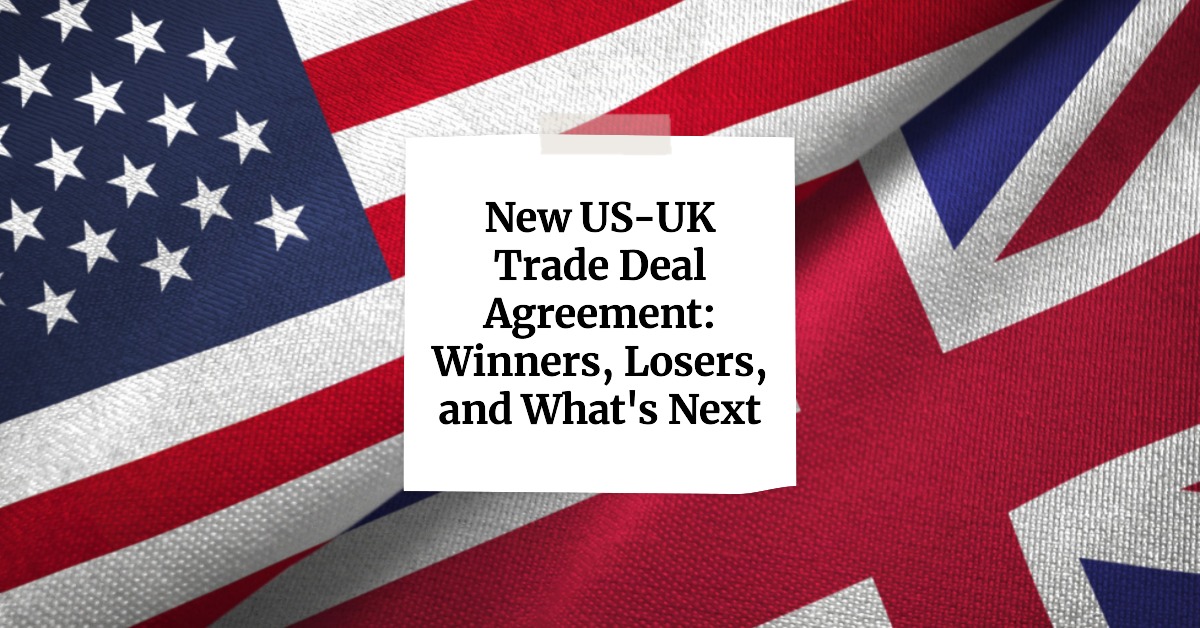Have you ever felt like two old friends, despite living far apart, finally found a way to make things a bit easier when they visit each other? That’s kind of what the new US-UK trade deal agreement, announced on May 8, 2025, feels like in the world of economics. This agreement is a step forward in how the United States and the United Kingdom do business together, aiming to smooth out some of the bumps and make trade a little less complicated. Essentially, it's a pact to lower some of the taxes and rules that make it harder for goods to travel between these two countries.
New US-UK Trade Deal Agreement: Winners, Losers, and What's Next
Now, don't get me wrong, this isn't a complete overhaul of everything. Think of it more like agreeing to share some favorite snacks without all the usual fuss, rather than opening up a giant, unlimited buffet. While it does bring some immediate benefits, like making it cheaper to trade certain things like steel, aluminum, and cars, and opening up new doors for American farmers to sell more of their goods in the UK, it's also important to keep things in perspective. A significant chunk of trade between the two nations still faces the same old 10% tax when entering the US. So, while it’s a welcome development, it's not the whole story.
One of the things I find most interesting about this deal is how it touches on some pretty important debates. For instance, there's been a lot of chatter about food safety standards. Imagine if your friend had a different way of preparing food that you weren't entirely comfortable with – that’s a bit like the concerns some people have about things like US beef coming into the UK. Then there's the angle of fairness. Some folks in the US who make cars and work closely with Canada and Mexico are wondering if this deal gives UK carmakers an unfair advantage.
At the end of the day, it feels like everyone's trying to see the good in this. Leaders on both sides are talking about how this will protect jobs and create new opportunities. And in some ways, I can see their point. For certain industries, this could be a real boost. But I also hear the voices of those who worry that it doesn’t go far enough in cutting down those pesky tariffs and might not be the magic bullet that completely transforms the UK economy after leaving the European Union.
Diving Deeper: What Exactly Does This New Trade Deal Entail?
So, you might be asking, what’s actually in this new US-UK trade deal? Well, on that day back in May 2025, which, interestingly, was also the 80th anniversary of Victory in Europe Day, the US and the UK presented this agreement as a significant moment in their long-standing economic relationship. It’s the first trade deal struck since the US decided to put tariffs on imports from many countries back in April 2025. The main goals are to lower the costs of trade, make it easier for businesses to access each other’s markets, and generally strengthen the economic security between the two nations.
Let's break down some of the key areas this deal covers:
- Tariff Reductions and Quotas: This is where things get specific. The agreement outlines exactly which goods will see lower taxes (tariffs) and how much of those goods can be traded without these tariffs or at a reduced rate (quotas). Here’s a quick rundown:
Sector US Provisions UK Provisions Agriculture Reallocates a certain amount of existing quotas for UK beef. Removes a 20% tariff on a small amount of US beef and creates a larger duty-free quota. Offers a duty-free quota for a significant amount of US ethanol. Addresses some concerns around Sanitary and Phytosanitary (SPS) standards and aims to improve export processes. Automobiles Sets a limit of 100,000 UK-made cars that can enter the US with a reduced 10% tariff (down from a much higher 27.5%). Also includes some arrangements for car parts. Benefits from the lower US tariffs, especially for luxury car brands that sell a lot in the US. Steel/Aluminum Eliminates the existing 25% tariffs, bringing them down to 0%. It also sets up a “Most Favored Nation” (MFN) quota for UK steel and aluminum, tied to meeting US supply chain security standards. This was a big win for the UK steel and aluminum industries, as these tariffs had been a major hurdle. It essentially creates a more secure trading relationship for these essential materials. - Tackling Non-Tariff Barriers: It's not just about taxes. Sometimes, different rules and regulations can also make trade difficult. This deal aims to smooth out some of these “non-tariff barriers,” especially in agriculture. The idea is to make the standards for things like food safety and plant health more aligned and to make the process of checking goods for export easier. They're also looking at building on existing agreements that recognize each other's standards for industrial goods and trying to work out similar deals for services, which is a huge part of the US-UK economic relationship.
- Boosting Digital Trade and Economic Security: In today's world, so much business happens online. This agreement has some forward-thinking parts that aim to make digital trade smoother, like encouraging paperless transactions and the digital movement of goods, particularly in financial services. There's also a focus on economic security, with both countries promising to work together on things like making sure investments are safe, controlling what goods can be exported for security reasons, and cracking down on people trying to avoid paying duties. This seems to tie in with the UK’s recent efforts to strengthen its national security and procurement processes.
- Other Important Pieces: The deal also touches on things like protecting intellectual property (like patents and trademarks), ensuring fair labor practices (including fighting against forced labor), and working together on environmental policies. Interestingly, there's also a clause that allows either country to end the agreement if they give written notice, which suggests that while it's a significant step, it's not necessarily set in stone forever.
Why Does This Agreement Actually Matter?
From where I stand, this new US-UK trade deal has implications on a few different levels.
For the United Kingdom, this deal is part of a broader strategy to find new trading partners after leaving the European Union. Think of it as trying to build a new network of friends after moving away from your old neighborhood. The US is a massive market, so having easier access is a big deal. This agreement could potentially safeguard jobs in important sectors like car manufacturing and steel production, which have faced uncertainty. Plus, opening up the US market more for some UK goods could mean new opportunities for businesses to grow and sell more.
On the other side of the pond, for the United States, this aligns with a more “America First” approach to trade. The idea is to boost American exports and support domestic industries. For example, American farmers now have a better chance to sell more beef and ethanol in the UK, which is a win for that sector. The deal also seems to be about trying to level the playing field in international trade, especially given the large amount of goods the US already trades with the UK.
However, it's important to be realistic about the overall economic impact. While the deal might protect some jobs in the UK and open up new markets for some US products, many economists believe that the immediate economic boost might be relatively small. This is partly because a lot of the trade between the US and the UK is actually in services (things like finance, technology, and consulting), which aren't directly affected by tariffs on goods.
Looking Closer at the Concerns and Criticisms
No big agreement comes without its share of worries, and this new US-UK trade deal is no exception. Here are some of the main points of concern that I’ve been following:
- The Scope Feels Limited: One of the most common criticisms is that the deal doesn’t go far enough. Many tariffs, including the 10% baseline tariff the US has on most imported goods, remain in place. Some experts argue that this means the deal doesn't really address the core issues that make trade expensive between the two countries. It's like fixing a leaky faucet while ignoring the bigger problem of a damaged roof.
- Food Safety Debates Are Brewing: The issue of food safety standards, particularly around US beef, has definitely stirred up some debate. There are concerns in the UK that allowing more US beef into the market, especially if it’s produced using different standards (like the use of hormones), could put British farmers at a disadvantage and potentially lower food safety standards for consumers. Even though there have been assurances that UK standards will be maintained, the worry about competition from potentially cheaper, lower-standard products is still there.
- Unease Among US Automakers: Interestingly, some car companies in the US are not entirely happy with this deal. They’re worried that by reducing tariffs on cars coming from the UK, it might give UK car manufacturers an edge over those in North America who operate under different trade agreements (like those with Canada and Mexico). The concern is that this could disrupt the existing trade dynamics within North America.
- Overall Economic Uncertainty: While the deal is seen as a positive step by some, there's still a lot of broader economic uncertainty around the world. Even the Governor of the Bank of England has pointed out that while this deal is welcome, more comprehensive trade agreements might be needed to really counter the global economic headwinds. Some economists also note that the UK's economic growth forecast isn't particularly strong right now, and domestic issues like tax changes might have a bigger impact than this trade deal in the short term.
What Does This Mean for the Bigger Picture?
From my perspective, this new US-UK trade deal is a significant event, but it’s also important to see it in the context of the broader global trade landscape.
For the UK, this deal is one piece of a larger puzzle as it tries to redefine its trade relationships after Brexit. They’ve also been working on deals with other countries, like India. However, it’s clear that the European Union remains their biggest trading partner by far. So, while deals with countries like the US are important, progress in its relationship with the EU is likely to have a much more substantial impact on the UK economy.
For the US, this deal is an interesting test of its current trade strategy, which has involved using tariffs more assertively. They’re also looking into trade practices in other sectors, like pharmaceuticals, which suggests that more trade negotiations could be on the horizon.
What I find particularly noteworthy is the emphasis on things like supply chain resilience and digital trade in this agreement. This reflects the changing priorities in international commerce, where it’s not just about the physical movement of goods anymore. However, the fact that some key issues, like food standards and those remaining tariffs, weren’t fully resolved suggests that this deal might be more of a starting point for future discussions rather than a comprehensive free trade agreement.
In Conclusion: A Bridge Built, But More Work Ahead
The new US-UK trade deal announced in May 2025 is undoubtedly a step towards closer economic ties between the two major global players. It brings tangible benefits, like lower tariffs on certain goods and increased market access in specific sectors. For people working in the auto and steel industries in the UK, and for American farmers, this agreement could offer a sense of greater security and new opportunities.
However, it's crucial to acknowledge that this deal isn't a magic bullet. Its limited scope means that many existing trade barriers remain, and concerns about food safety and potential disadvantages for some industries are valid and need to be carefully monitored.
Ultimately, I see this agreement as a pragmatic move – a bridge built between the US and the UK in a complex global economic environment. It lays a foundation for future cooperation, but its true success will depend on how both nations address the existing criticisms and how willing they are to expand their reach in future years. For now, it stands as a testament to the enduring, albeit sometimes complicated, “special relationship” between these two allies.
Capitalize on Global Trade Shifts with Turnkey Real Estate
The recent US-UK trade agreement is reshaping international markets. Investors are seeking stable, cash-flowing assets to navigate these changes.
Norada offers a curated selection of turnkey rental properties in resilient U.S. markets, providing consistent income and long-term appreciation potential.
HOT NEW LISTINGS JUST ADDED!
Connect with a Norada investment counselor today (No Obligation):
(800) 611-3060
Read More:
- April 2025 Jobs Report: Economy Adds 177K Jobs Amid Trade War Fears
- Bond Market Today and Outlook for 2025 by Morgan Stanley
- The Risk of New Tariffs: Will They Crash the Stock Market and Economy?
- Stagflation Alert: Economist Survey Predicts Weak Q1 GDP Due to Tariffs
- Goldman Sachs Significantly Raises Recession Probability by 35%
- 2008 Crash Forecaster Warns of DOGE Triggering Economic Downturn
- Stock Market Predictions 2025: Will the Bull Run Continue?
- Stock Market Crash: Nasdaq 100 Tanks 3.5% Amid AI Concerns
- Stock Market Crash Prediction With Huge Discounts on Bitcoin, Gold, Houses
- S&P 500 Forecast for the Next Year: What to Expect in 2025?
- Stock Market Predictions for the Next 5 Years
- Echoes of 1987: Is Today’s Stock Market Crash Leading to a Recession?
- Is the Bull Market Over? What History Says About the Stock Market Crash
- Wall Street Bear Predicts a Historic Stock Market Crash Like 1929
- Economist Predicts Stock Market Crash Worse Than 2008 Crisis
- Next Stock Market Crash Prediction: Is a Crash Coming Soon?
- Stock Market Crash: 30% Correction Predicted by Top Forecaster





